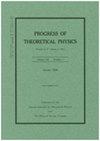A Conceptual Model to Explain Dark Matter and Dark Energy
引用次数: 0
Abstract
This paper considers a conceptual model that attempts to explain ‘Dark Matter’ and ‘Dark Energy’. The model is based on considering a gravitational field to be the result of a mass (a Higgs field) scattering pre-existing cosmic background space-time waves or ‘Uber-waves’. The term ‘Uber’ is used to denote an outstanding or supreme example of a particular kind of gravitational wave with cosmic-scale wavelengths that are far in excess of those associated with the gravitational waves generated by accelerating masses. Such waves are taken to be the very lowest frequency components associated with the spectrum of space-time waves generated by the ‘Big Bang’ and are supported by the expanding fabric of space-time produced at the point of the big bang, i.e. the lowest frequency components of a cosmological spectrum whose bandwidth is the a Planck frequency (~10∧43 Hz). Like electromagnetic waves, Uber waves are taken to propagate with an upper velocity consistent with the speed of light and interact with, and are scattered by, a Higgs field. This interaction produces the effect of a mass locally curving space-time, an idea that is contrary to the conventional model associated with General Relativity where mass is taken to curve space-time directly which otherwise remains ‘flat’. By assuming the pre-existence of background Uber waves, we consider the concave curvature of such waves to generate an apparent attractive gravitational force. This interaction produces the effect of a mass locally curving space-time, an idea that is contrary to the conventional model associated with General Relativity where mass is taken to curve space-time directly which otherwise remains ‘flat’. By assuming the pre-existence of background Uber waves, we consider the concave curvature of such waves to generate an apparent attractive gravitational force. This attractive force is taken to govern the formation of large scale structures of matter (galaxies and super-clusters of galaxies, for example) in the conventional sense but surrounded by a residual background gravitational field. It is this residual field that gives rise to the effect known as dark matter where more gravity (as an attractive only force) appears to be available than that which can be accounted for by the observed (luminous) mass, a luminosity that is generated primarily by nuclear fusion in stars. The convex curvature of Uber waves is considered to account for cosmic voids within which gravity is a repulsive force and where large scale structures of matter can therefore not be formed. This is considered to explain the super-large cosmic voids or super voids that are observed. These are regions of the universe where there is an absence of rich super clusters of matter. In these anti-gravity zones, only relatively small structures of matter can be formed by electrostatic forces alone which are then repelled from each other when their mass becomes significant enough for the force of anti-gravity to become significant. In such regions of an Uber wave, the matter generated from electrostatic forces builds up to produce a weak gravitational repulsive field due to the low mass density within a void. However, due to the immense size of these cosmic voids, they are taken to generate a net repulsive force which is considered to be the reason for the acceleration associated with the expansion of the universe; the effect of dark energy. This effect also accounts for the cosmic web structure in which luminescent matter appears to exist in relatively thin connective filaments. The purpose of this paper is to provide a conceptual model and not to investigate the ideas proposed in any significant mathematical detail. This is accomplished by building up the ideas on a case-by-case basis, coupled with a series of thought experiments but without resorting to specific physical scales or the physical parameters associated with these scales other than, by default, the speed of light and Newton’s gravitational constant.解释暗物质和暗能量的概念模型
本文考虑了一个试图解释“暗物质”和“暗能量”的概念模型。该模型是基于考虑引力场是质量(希格斯场)散射预先存在的宇宙背景时空波或“优伯波”的结果。“优步”一词用来表示一种特殊引力波的杰出或最高例子,这种引力波的宇宙尺度波长远远超过由加速质量产生的引力波。这种波被认为是与“大爆炸”产生的时空波频谱相关的最低频率成分,并由大爆炸点产生的时空结构的膨胀所支持,即带宽为普朗克频率(~10∧43 Hz)的宇宙频谱的最低频率成分。像电磁波一样,优步波以与光速一致的速度传播,并与希格斯场相互作用,并被希格斯场散射。这种相互作用产生了质量局部弯曲时空的效应,这一想法与广义相对论的传统模型相反,广义相对论认为质量直接弯曲时空,否则时空就会保持“平坦”。通过假设背景优步波的预先存在,我们考虑这种波的凹曲率来产生明显的吸引引力。这种相互作用产生了质量局部弯曲时空的效应,这一想法与广义相对论的传统模型相反,广义相对论认为质量直接弯曲时空,否则时空就会保持“平坦”。通过假设背景优步波的预先存在,我们考虑这种波的凹曲率来产生明显的吸引引力。这种吸引力被认为支配着传统意义上的大尺度物质结构(例如星系和超星系团)的形成,但被残余的背景引力场所包围。正是这个残余的场产生了被称为暗物质的效应,在那里,引力(作为唯一的吸引力)似乎比观测到的(发光)质量更有效,发光主要是由恒星的核聚变产生的。优步波的凸曲率被认为是宇宙空洞的原因,其中引力是一种排斥力,因此无法形成大规模的物质结构。这被认为可以解释观测到的超大宇宙空洞或超级空洞。这些是宇宙中缺乏丰富物质超星系团的区域。在这些反重力区域中,只有相对较小的物质结构可以单独由静电力形成,当它们的质量变得足够大,使反重力变得显著时,它们就会相互排斥。在优步波的这些区域,由于空洞内的低质量密度,静电力产生的物质积聚起来,产生一个弱的引力排斥场。然而,由于这些宇宙空洞的巨大尺寸,它们被认为产生净排斥力,这被认为是与宇宙膨胀相关的加速的原因;暗能量的影响。这种效应也解释了宇宙网结构,其中发光物质似乎存在于相对较薄的连接细丝中。本文的目的是提供一个概念模型,而不是在任何重要的数学细节中研究所提出的想法。这是通过在个案的基础上建立思想,加上一系列的思想实验来完成的,但不诉诸于特定的物理尺度或与这些尺度相关的物理参数,除了默认的光速和牛顿引力常数。
本文章由计算机程序翻译,如有差异,请以英文原文为准。
求助全文
约1分钟内获得全文
求助全文

 求助内容:
求助内容: 应助结果提醒方式:
应助结果提醒方式:


